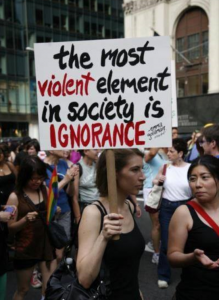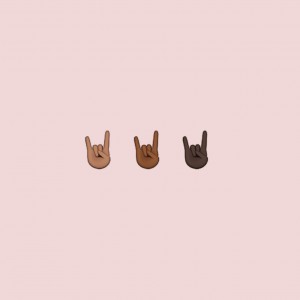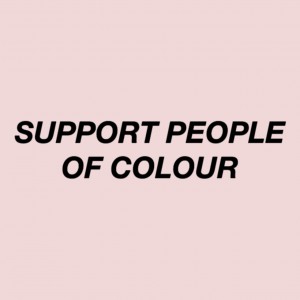Tuesday
UncategorizedContinuous Reconciliation
A Reconciliation of Two Identities: Understanding Non-Violence as a Person of Colour and a Buddhist Practitioner
New Column: Critical Intent
By Nina Eslambolipour
 On a long car ride to Boston, I share with my friend the challenges of implementing non-violent action in the face of micro-aggressions as a young woman of colour. I am hoping that as a practitioner of meditation this friend will understand the difficulty of responding with skillful means to aggression. He explains to me that no matter what, I must always respond with non-violence in the face of aggression because “an eye for an eye makes the world blind.” I should look to Martin Luther King Jr., who is the epitome of correctly responding to violence. He talks about non-violence over aggression as if it were simply a decision between the two.
On a long car ride to Boston, I share with my friend the challenges of implementing non-violent action in the face of micro-aggressions as a young woman of colour. I am hoping that as a practitioner of meditation this friend will understand the difficulty of responding with skillful means to aggression. He explains to me that no matter what, I must always respond with non-violence in the face of aggression because “an eye for an eye makes the world blind.” I should look to Martin Luther King Jr., who is the epitome of correctly responding to violence. He talks about non-violence over aggression as if it were simply a decision between the two.
What I had hoped would be a conversation between the two of us has turned into a monologue. When he finishes, I attempt to articulate that: 1. to consciously sit with the emotions of pain, shock, and anger that arise when processing ignorance takes incredible patience and practice, and 2. to respond in a skillful way does not necessarily mean being “calm” and “rational.”
As I speak I notice him becoming defensive and as a result I become irritated Not realizing it then, I had overlooked the fact that although he is well versed in Buddhist philosophy, he has never had to personally combat the oppression that arises from the ignorance of others. I wonder when he steps out of this car and continues on his journey, will he think about this conversation again? Will it hold the same impact for him as it does for me? I do not think we have heard each other.
______________________________________________________________
 When I take a seat on the cushion I look around the room at my Sangha. I notice I am one of only a few people of colour in the room. The reality is that Western Buddhism is generally comprised of older, white, middle- to upper-class people. Most of the time when I have conversations, both within and outside of my Sangha, the conversations are similar to the one I had with my friend: based upon a privileged perspective that doesn’t hear or understand my experience as a person of colour. While I agree that regardless of race, class, and gender, it would be undeniably helpful to ourselves, our communities, and the world, to always be able to respond with non-aggression, this is not realistic. What is often overlooked in the practice of non-violence are the similarities between non-violence and subservience, and how much more challenging a non-violent response can be depending on one’s class, race, and gender. It takes incredible energy and patience for people who experience oppression to choose non-violence. It is not an easy task; it is consuming and informs every aspect of our lives.
When I take a seat on the cushion I look around the room at my Sangha. I notice I am one of only a few people of colour in the room. The reality is that Western Buddhism is generally comprised of older, white, middle- to upper-class people. Most of the time when I have conversations, both within and outside of my Sangha, the conversations are similar to the one I had with my friend: based upon a privileged perspective that doesn’t hear or understand my experience as a person of colour. While I agree that regardless of race, class, and gender, it would be undeniably helpful to ourselves, our communities, and the world, to always be able to respond with non-aggression, this is not realistic. What is often overlooked in the practice of non-violence are the similarities between non-violence and subservience, and how much more challenging a non-violent response can be depending on one’s class, race, and gender. It takes incredible energy and patience for people who experience oppression to choose non-violence. It is not an easy task; it is consuming and informs every aspect of our lives.
I have also noticed in conversations concerning non-violence that MLK Jr. is almost always brought up as an example. When referencing him in these conversations we need to be aware of whom we are speaking to, and depending on the way we craft our language, we may be in danger of reducing him and his work into a monolith of how people of colour should behave. Please do not neglect the fact that his entire life was devoted to combating inhuman manifestations of racism. Non-violence was not something he thought about every so often or sometimes had a casual conversation about. Non-violence was his being and he was murdered for his beliefs. In order to speak of non-violence and be well informed, we must first recognize how our perspectives are informed by our privilege and experience, or lack of experience, with violence.
 There is an expectation for individual people of colour to respond with non-violence when confronting violence, rather than focusing on the various factors that cause racial inequality. It is our own responsibility to educate ourselves not only on how oppression works, but how our own perceptions and actions contribute to racial oppression. People of colour are not supposed to be teachers who will peacefully guide you through your ignorance. When, as people of colour, we do speak on these issues the point is not for us to calmly get our message across so as to not hurt your feelings, cause tension, or create a “problem.” For us to try and do so would not necessarily be compassionate.
There is an expectation for individual people of colour to respond with non-violence when confronting violence, rather than focusing on the various factors that cause racial inequality. It is our own responsibility to educate ourselves not only on how oppression works, but how our own perceptions and actions contribute to racial oppression. People of colour are not supposed to be teachers who will peacefully guide you through your ignorance. When, as people of colour, we do speak on these issues the point is not for us to calmly get our message across so as to not hurt your feelings, cause tension, or create a “problem.” For us to try and do so would not necessarily be compassionate.
What does non-violence look like?
In order to practice non-violence it is necessary to have compassion. Typically the characteristics of compassion that we think of are empathy, openness, and understanding. However, there are qualities of compassion less commonly thought of: honesty, sharpness, and firmness. When combating ignorance it is necessary to implement these qualities because there is a difference between skillful compassion and what is referred to as “idiot compassion.”
Idiot compassion is described as shying away from direct action in a situation because we are more concerned with a cliché concept of compassion. Buddhist practitioner Bodhipaksa says, “Idiot compassion lacks courage because ‘being nice’ and ‘being good’ are held to be the most important qualities we can manifest, and so we’re afraid to do anything that might make us unpopular. True compassion does not shy away from causing pain when necessary.” In the context of a dialogue about non-violence, pain means feeling uncomfortable. There is no way around this one. If we want to grow we need to feel uncomfortable.
To demonstrate an example of this, my last name is constantly commented on. I can never get around the barrage of comments about how long and “different” it is. One day I was picking up photos from Walgreens when the gentleman who was helping me said, “Oh, you’re the one with the weird last name.” His remark was small and in most cases like this I remain silent. In this instance I chose to be completely honest and said, “Actually my name isn’t weird, it’s just culturally different and I don’t appreciate you saying it’s weird.” He quickly apologized and seemed embarrassed afterwards. Telling him how I felt put us both in an uncomfortable position, but in the end he’s going to think before he speaks that way about someone’s name, and I practiced speaking up instead of remaining silent.
Conclusion
 Talking about non-violence and racial justice can be difficult. If you are a person of colour it can feel exceptionally challenging. If you consider yourself an ally, when a person of color opens up to you about their experiences, please just listen. Do not dominate the discussion or approach it as a friendly debate. Your intentions may be good, but in the long run you’re helping perpetuate systematic oppression. People of colour deserve to be listened to – our truth serves as a chance for growth within the mandala and as a larger society.
Talking about non-violence and racial justice can be difficult. If you are a person of colour it can feel exceptionally challenging. If you consider yourself an ally, when a person of color opens up to you about their experiences, please just listen. Do not dominate the discussion or approach it as a friendly debate. Your intentions may be good, but in the long run you’re helping perpetuate systematic oppression. People of colour deserve to be listened to – our truth serves as a chance for growth within the mandala and as a larger society.
As a Buddhist practitioner I have placed an expectation upon myself that I should move through life with equanimity and gentleness; especially when I am having these difficult conversations. This is unreasonable because I am misinterpreting what a “good” Buddhist looks like. The greatest teaching I have absorbed from Shambhala is that wherever you are at emotionally or mentally is fine. It is okay for me to be reactive, impatient, and irritable. Thankfully I know all of this about myself and am working on responding to others with skillful compassion. I am slowly coming to understand what it means to be Buddhist as a young woman of colour.
Nina Eslambolipour is a first generation Middle Easterner. She is a recent graduate of Marlboro College and is currently working at a non-profit in Western Massachusetts.





May 6, 2016
Reply
Some contemplations:
(1) Non-violence might not be equal to silence, oppression, or ignorance.
(2) Silence might not be equal to oppression or ignorance. Some people view silence as patience, and wait for wisdom to solve the problem.
(3) Some kinds of compassion might be too “aggressive”.
(4) Because we do not know what people are thinking about in their mind (silent, oppressed, or ignorant), it might be good to respect their thoughts and actions, without judgement.
Apr 28, 2016
Reply
Hey Steven don’t know if this is coming too late, but please go for it~
Apr 27, 2016
Reply
Thank you. It was very helpful for me to read your article.
Apr 18, 2016
Reply
White people, please! Please stop having an opinion on how people of colour “should” respond/act/feel.
Nina- THANK YOU! It is not your job to educate us, and out of your generosity, you did. I so appreciate your words, your experience and your sharing it with our sangha.
Apr 17, 2016
Reply
Thank you Nina! I hear you. I am grateful for your articulation of these complex feelings and issues. I’ve got work to do.
Apr 16, 2016
Reply
Last year, I had a reaction when the Charleston Massacre shooter was brought to court. All of the congregants that attended the hearing spoke of forgiving Dylan and – to paraphrase – wished him peace and so on. My reaction was a result of noticing the contrast of Black Lives Matters members in various protests. The protesters are mostly young, energetic and mad as hell; their actions were/are perceived as violent, loud, and destructive. In contrast, the Mother Emmanuel congregants were quiet, “godly”, and good. My reaction was anger.
I am generally perceived as quiet until I get to know you. Then, I will be loud, sarcastic, playful and outspoken – all mixed in with loving. In general, this is difficult for me to maintain, as I have a lot of cultural, socio-economic, and gender biases imposed upon me not only from others, but from myself, having lived in Chicago most of my life. Really good friends are able to make space for the paradox that is me, and I attempt to do the same, but it is really difficult. My reaction came from noticing that Majority Americans are OK with the MLK’s of the lot, but not the Malcolm X’s. There is a time and place for both of these figureheads, and in a landscape of garish social media in which people have more choices to surround themselves with perspectives that confirm their current worldview, I believe it is necessary for the minority to be louder.
I, too, struggle with finding the Middle Way within compassionate, skillful action. I am not a representative for all Buddhist and Queer POC – and never will be – but I believe that no one is “wrong” in their expressions, especially if they are making an honest way along the path. Everyone’s perceptions are flawed to some degree and I think that in actively working with that limitation, we can open ourselves up to actually bearing witness to others’ experiences and seeking out compassionate action to alleviate our collective suffering. That is my perceived value of the sangha, of which I am always grateful.
Thank you for sharing this, Nina.
P.S. – I’ve had over 35 years of people messing up my first and last name and commenting on it in the way you described. Also, I’m not sure why, but it annoys me when people ask for its meaning. Americans rarely ask, “What does ‘Laura” mean?”, as an example. I feel put on the spot when asked that, and a lot of people add that to my “exotic-ness”. And I have also heard people comment on names like “Travonda” and scoff at its “made-up-ness”. Aren’t all names made-up, as language is just a way to externally communicate internal concepts such as who we are to our parents?
Apr 15, 2016
Reply
This is a wonderful article. As a SEED Facilitator, I have taken this message to heart. We have a Cultural Humility class coming up at our Center in Minneapolis and I’d like to be able to share with the other participants. Please let me know if you are willing to grant your permission. Thank you.
Warmly,
Steven
Apr 15, 2016
Reply
Thanks so much for this.
The default mode/reaction too often in one’s mind is I
‘should’ or ‘shouldn’t’ be/feeling this way.
And you’re so right, to do the work – that is, catch that
state-of-mind & go beyond it, IS work.
But it’s the only way to get at my/one’s own prejudices,
& begin to actually see the situation clearly.
At that point compassion can begin.
Apr 15, 2016
Reply
Thank you, Nina!! I’m so pleased you’ve created this column. I appreciate your thoughts on compassion – that sometimes it’s sharing uncomfortable truths that might initially appear as non-supportive.
Apr 13, 2016
Reply
Thank you so much for writing this.
Apr 13, 2016
Reply
Your experience with your friend in the car may be as much a male / female difference in approach as a white / black or privileged / underprivileged distinction. We men are sometimes fixated on answers and results rather than process or relationship — and when we get like this we can be dumb as a bag of hammers.
I do think our culture’s racial prejudices affect us all. I was reading CTR’s teachings on the eight consciousnesses and, coincidentally, had recommended to me a Harvard sponsored website where you can take “implicit association tests” (IATs). It can be quite shocking to take these tests — particularly, I think, the test on racial bias. And after reading about the eight consciousnesses, the test seems to me to be a perfect illustration of how our dualistic minds create samsara. If you Google Harvard and IAT, you can find the site.
Apr 12, 2016
Reply
Thank you. I am grateful for this article which well expresses many of the thoughts, feelings and experiences I have had personally at times – not as a person of color – but as a trauma survivor on the path. W.E.B. DuBois’s ideas concerning double consciousness might be helpful for further contemplation of what it can feel like being in relation in these contexts. Most of us likely carry multiple cultural identities, experiences and complex mixtures of consciousness at all times – how do we hold all those that may be in tension together in our awareness with greater compassion and authenticity?
Apr 12, 2016
Reply
My heart goes out to you and all those in the position of facing down the ignorance of a system while on the outside of it and trying to be an uplifting part nonetheless. I appreciate such fearlessness very much.
Apr 12, 2016
Reply
thank you for sharing Nina. The information, your experiences & suggestions helpful, wise, kind and strong.
Apr 12, 2016
Reply
Thank you Nina for a very powerful article.
Apr 12, 2016
Reply
Thank you, Nina. I appreciate your clear expression and benefit from hearing over and over again the power of just listening.